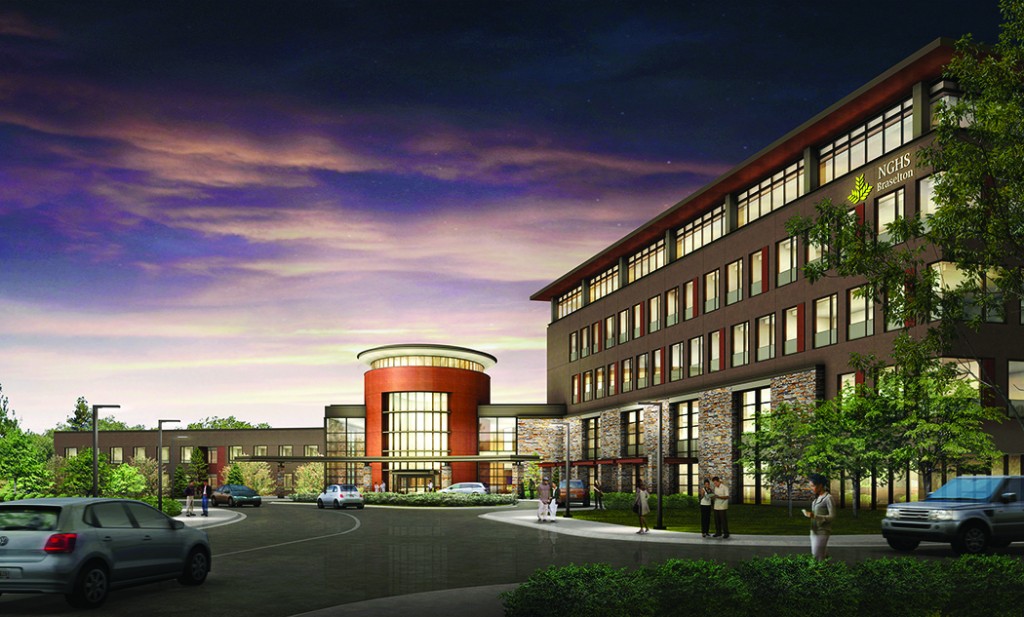The healthcare industry is undergoing major changes, propelled by new models for delivering healthcare with a growing emphasis on wellness and preventive care. Sustainable design for healthcare is likewise evolving. There is an emerging focus on creating spaces that promote patient health and community well-being.
Traditionally, sustainable design centered on the building itself, concentrating on reducing a negative environmental impact or “doing less bad.” Now, sustainable design emphasizes making things better by promoting net-positive building performance and by elevating the human experience to improve overall health of communities with facilities that are visibly healthy.
While energy, carbon, water, waste, materials and land use have dominated the sustainable design conversation in the past, the human impact of buildings is emerging as a top priority for healthcare organizations, designers and community leaders. Individual and community behavior can be influenced to promote health and well-being by elevating design to prioritize the human experience perspective in healthcare sustainable design.
Within a healthcare environment — or any workplace environment — building occupants function on three basic human scales: individual, co-workers and community. Properly considering each scale gives a new look and fresh solutions that help shape the future of facility design and healthcare services.
Taking a human-scale approach to healthcare design assumes there is social and community aspects of sustainability, and further reinforces the concept that the buildings we live and work in create social connections that promote health. By breaking down the sustainable healthcare design process into the three human scales, it’s easy to see how each impacts the other. Asking the right questions can lead to better design and improved experiences for staff and patients.
Individual scale
What ability to adapt and customize working conditions is needed for individuals? How much private workspace is needed compared to collaborative space? Providing spaces for individual quiet work with the flexibility to adjust workspace configuration temperature and lighting to suit individual needs is important for staff satisfaction, work performance and a feeling of well-being. As the trend toward collaborative environments continues, it will remain important to provide for individual needs, including quiet spaces for concentration. These solitary spaces should be warm and inviting but not isolating, optimally adjacent to group work areas. Spaces that have visual interest without being distracting can provide a stimulating place to be productive for individual work and prepare people for teamwork and collaborative sessions.
Co-workers
What is needed to make teamwork effective without interfering with colleagues doing concentrative work or working one-on-one with patients? A growing trend in healthcare delivery is open, collaborative planning that supports team interactions immediately adjacent to patient encounter spaces. As this continues, it is important to balance the needs between collaboration and individual work tasks.
Acoustic treatment of open collaborative spaces is important so quiet work can be accomplished and patients’ privacy can be maintained. Consideration should also be given to adjacencies. Active teaming areas next to quiet private areas can be challenging. Proper consideration of space and function help focus attention on acoustic separation even when visual connection is needed.
Additionally, the building itself contributes to the health of the people through its design. Simple gestures can make a big difference. Nursing staff walk a lot during the day, so placing supplies close to patient-care areas is important to reduce wasted time walking instead of serving patients. However, walking for exercise should be encouraged, so making stairs visible near elevators to give people a choice improves the health of building users. The connection between design and human health will help guide future facilities and planning efforts.
Community
What healthcare facility features and services can provide a positive impact on the overall health and wellness of the broader community? First, design excellence creates the potential for a building to be a neighborhood focal point. If the building is inspiring, people will be drawn to it. Buildings designed with a sense of transparency help the community see in and staff to see out, thus figuratively drawing in the community to consider health and wellness. Healthcare buildings should have the appearance of being healthy and sustainable. Providing walkable communities and campus environments are essential aspects of overall health and wellness.
A new school of nursing for a university academic medical center in northern California, for instance, illustrates the impact of sustainable design at these three human scales. The building will make health information visible to occupants and will have a sense of transparency, inviting the community to “come in.” The building will provide individual quiet spaces and interactive team spaces. There will be an emphasis on productive learning environments for medical students, with interactive classrooms supported by common spaces for learning with both teaming and individual work areas. Additionally, training and leadership development programs within the facility will build connections between the campus and its community to promote health and wellness.
Healthcare facilities are energy-intensive machines consisting of vast and complex infrastructure, state-of-the-art medical technology and highly specialized programming. Yet within this vast machine is the individual — whether a patient, caregiver or administrator. By focusing on the three metrics of human scale, healthcare organizations and designers can personalize sustainable design at the individual level, provide for concentrative work and team spaces and broaden sustainability at the community level. Designing sustainable healthcare environments at the human scale promotes a holistic approach to health and wellness, in which healthy environment, healthy behavior and healthy community support wellness and health.





